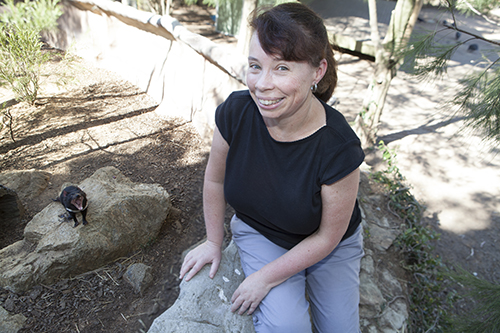Uncovering clues to save Tasmanian devil
Claudia Doman
19 June 2014:
It's not as cute or charismatic as the Looney Tunes cartoon character, but the Tasmanian devil is one of Australia's most endearing creatures. Also, it's one of the most endangered.
The population of this carnivorous marsupial has been decimated by a highly-transmissible cancer: the facial tumour disease.Since the tumour was detected in 1996, Tasmanian devil populations have declined up to 90 per cent in some areas.

|
Dr Janine Deakin gets up close and personal with her research subject at Canberra's National Zoo and Aquarium. Photo: Michelle McAulay |
But an army of researchers is fighting every day for their survival. Among them is University of Canberra scientist and Australian Research Council Future Fellow Janine Deakin, who has been investigating the evolution of this deadly tumour for the past five years.
Dr Deakin, a comparative genomics specialist, is comparing the normal devil genome to that of the tumour. Her investigation reveals how the tumour was initially formed and how it evolves as it spreads throughout the population.
"This disease is unusual in that it is a contagious cancer. It started in one animal and it spread across the whole population, and I'm interested in knowing how did this happen?" she said.
Known for its piercing calling screeches, its remarkable black colour and its reputed bad temper –which earned it its name – the devil was once a popular species all over Australia. It became extinct in the mainland about 500 years ago, and 20 years ago it could only be found roaming in the Tasmanian wild.
However, the facial tumour, which initially only affected one devil, now threatens the existence of this last community in the wild. Once infected, the animal dies within six months.
"The tumour originated in an animal over 17 years ago, has outlived its original host and has since passed through thousands of devils," the geneticist said.
According to Dr Deakin, the tumour itself is the infectious agent and since it developed around the mouth "it's easily transmissible".
"Biting each other around the face is a social behaviour displayed among devils. They bite each other during mating which infects healthy individuals, but transmission can also happen during communal feeding, which makes it harder to contain the spread."
Dr Deakin and her colleagues have discovered that the facial tumour initially developed in a female devil because "there was no Y chromosome genetic material found in the tumour."
The research data also provides some insight into how the tumour first formed. "It appears that two chromosomes were shattered and rejoined in a completely different order."
She explained that the cancer-causing agent can't live outside the devils. "It is transmitted like a virus but it's not caused by one."
Dr Deakin said that in an attempt to contain the spread of the disease, there have been major efforts to develop insurance populations in zoos or national parks in Australia's mainland and Tasmania by isolating non-infected devils so they can breed healthily in captivity.
Healthy devils have also been released in Maria Island, off the east coast of Tasmania, in order to raise a disease-free population in the wild.
In the meantime, by observing how the tumour genome is evolving in the wild, Dr Deakin is trying to determine if the tumour is changing to overcome resistance within the devil population. "We hope this is not happening," she said.
"The tumour may be evolving to become less virulent to Tasmanian devils, allowing them to ultimately survive and overcome this infection."
Her work could prove to be great news for the devils' population and a significant turning point in ensuring their survival in the future.


